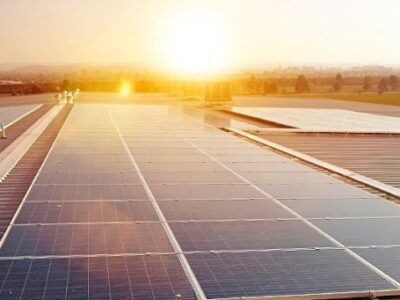
Farmers across the country are turning to a new revenue stream amid a decline in crop prices: solar energy. As erratic weather patterns across the Midwest have left farmers with fewer crops, many farmers are searching for ways to diversify their income streams. Installing solar panels on farmland has proven to be a lucrative and relatively easy way for growers to increase their profits.
The number of farms with solar panels increased almost 150 percent from 2012 to 2017, going from 36,000 to 90,000. And agricultural leaders seem to be in support of the trend. American Farmland Trust currently promotes the use of solar panels on farms and has held events in the past to educate farmers on their options.

According to the Wall Street Journal, there are two ways farmers can use their land to generate solar energy. They can lease their land to energy companies who will funnel power into the electricity grid or install solar panels themselves to cut down on their own electric bills. The cost of installing solar panels has gone down considerably, making the latter more affordable ever.
The economic benefits cut both ways. Farmers can earn a profit from installing solar panels, and solar developers typically save money by using farmland as opposed to other sites. Using farmland eliminates the need for grading methods to flatten the land. And farmland may also help improve solar power efficiency as the vegetation that grows under panels can lower soil temperature leading to increased performance.
Midwest Farms Set an Example with Embrace of Solar Energy
The trend of using farmland for solar power is particularly popular in the Midwest. Farmers in states such as Michigan, Minnesota, Illinois, and Iowa are using solar energy as a way to stay afloat financially and promote sustainable practices.
Michigan is particularly friendly to solar development given the state’s commitment to receiving 15 percent of its energy from renewable sources by the end of this year. A new policy from Michigan Governor Gretchen Whitmer allows farmers to keep their agricultural tax incentives should they choose to install solar panels. It’s a reversal of a previous decision that required farmers to end their contracts with the state before signing a commercial solar lease.
Michigan farmers John Forell and Kent Kraynak have taken advantage of Whitmer’s new policy and rented out a portion of their land to solar developers. They’ll be able to maintain their tax status as agricultural growers and grow their revenue through leasing their land.
Forell owns 5,000 acres in Eaton County where he grows corn, soybeans and wheat. He plans to lease 300 acres (6 percent) of his land to Geronimo Energy, a Minnesota-based solar developer. In business since the mid-80s, Forell’s farm has become a family affair with his son and daughter helping with day-to-day operations.
Forell expects the solar project to generate more revenue than his crops. “Each year is different with prices, but if I look at grain income now, I can get two or three times prices for solar than from crops,” he said. “Renewable energy companies needed land near substations and power lines to put solar panels and wind farms. We did due diligence and decided it was the avenue to go.”
Kraynak shares Forell’s positive economic outlook on solar: “The way the weather is, crop prices are, I can’t hardly make any money. Solar farming is guaranteed income. I don’t have to worry about the weather.”
In Saginaw Country, Kraynak also grows grains on his 100-acre farm. He leased 50 acres to Cypress Creek Renewables for them to install renewable energy panels. Luckily, he hasn’t heard any dissent from the local community. “They are more opposed to wind. Solar is so low to the ground. It actually is attractive to look at,” he said.
Other Benefits of Solar Power on Farms
Beyond the economics and aesthetics, solar energy can offer many other benefits. The Energy Foundation reports that solar panels on farms “create a virtuous cycle of improving land productivity” by providing shade to increase the production of grazing grasses. Further, moisture under the panels can evaporate and cool the panels on high heat days to increase power output. Solar panel sites may also support the growth of pollinator-friendly plants which helps reverse the alarming decline of pollinators such as bees, birds, and butterflies. Pollinators are essential for crop production, and maintaining pollinator-friendly plants will help increase the population of these important animals.
Solar installation sites can also bring needed jobs and economic development to rural areas. As Michigan Agri-Business Association President Jim Byrum said in a statement: “Solar energy provides farmers, agribusinesses and farm communities with a steady source of tax revenue while preserving farmland for future generations.”
Finally, and perhaps most importantly, farmland that’s been turned over to solar energy can be turned back into crop-yielding soil. If farmers determine that they can make more money growing crops on their land as opposed to generating solar power, they can choose to return the land to its original use. As Forell succinctly puts it, “If you build subdivisions and houses, that doesn’t come back to farmland.”





